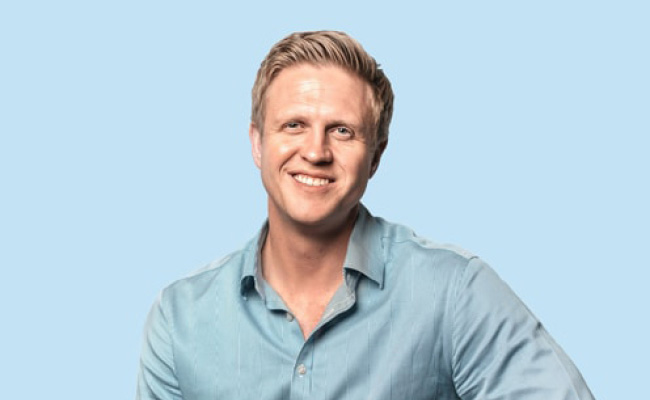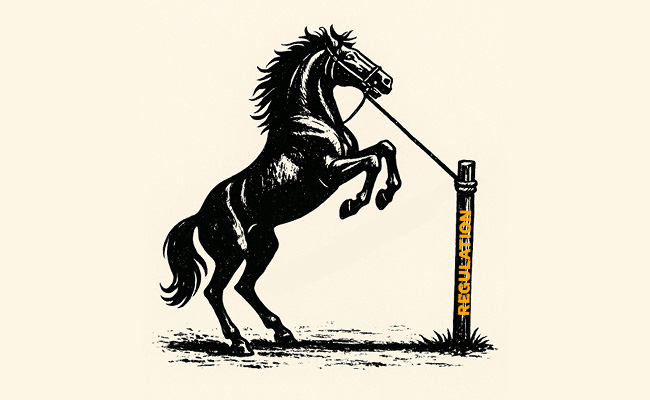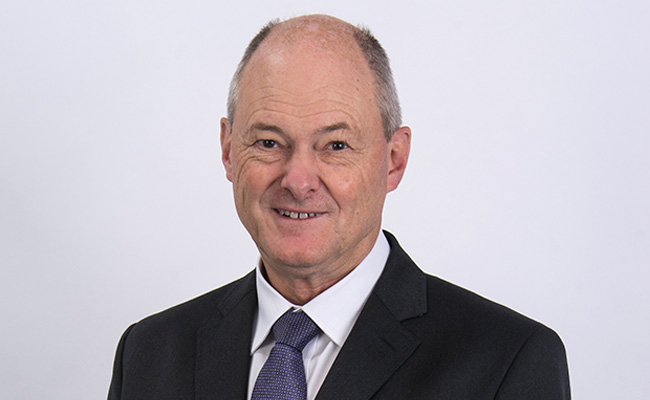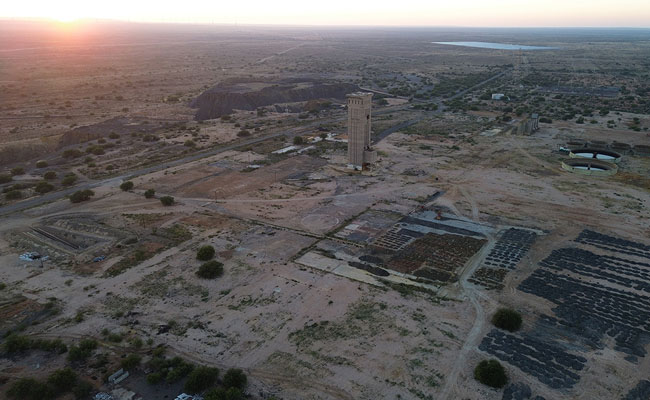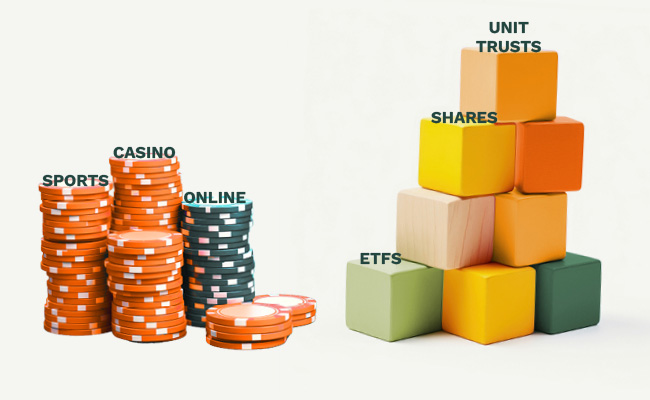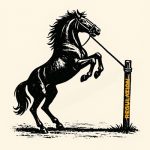Rademeyer Vermaak is the face of the new generation of asset manager.
As someone who reckons the days of ignoring AI and making investment decisions based on gut feel are “done”, Vermaak is somewhat unusual in the industry. If most asset managers are easy listening jazz, he is more Rage Against the Machine.
Yet as the manager of the Stanlib Enhanced Multi Style Equity Fund, few would argue with returns of 11.9% per year over the past seven years, compared to the benchmark of 10.2%. If you extend that to the fund’s launch date, it has delivered 11.1% per year, compared to the 9.7% benchmark.
Vermaak is unusual because, unlike many who slogged through institutional investments courses, he studied engineering, a course which steeped him in the importance of systems and programming.
If that sounds all very theoretical, here’s something that isn’t: his master’s dissertation for his electronic engineering degree was all about robot soccer.
“We put together a team of small little cubes with wheels that played soccer, and we actually represented South Africa in the RoboSoccer World Cup of that year. That was the year that the World Cup was hosted in Korea,” he says.
The idea was that by 2030, the technology would have advanced to the extent that a team of robots could take on the real-life champions. You probably don’t know this, but it’s got pretty damn close.
“I don’t know if you’ve seen lately the sort of videos of robots playing soccer in Japan, and it’s amazing how that’s progressed from the little boxes and wheels that we programmed all the way to actual humanoids kicking the ball,” he says.
In that tournament in 2002, Vermaak’s South African team got to the semifinals, beating Germany. “It was the first year we participated, but the Chinese were way ahead of us,” he says.
For those who reckon the one sport in which humans will continue outpacing the robots is soccer, it’s a bracing thought. And the RoboCup organisers have set themselves ambitious goals.
“By the middle of the 21st century, a team of fully autonomous humanoid robot soccer players shall win a soccer game, complying with the official rules of [governing body] Fifa, against the winner of the most recent World Cup,” predicts the organisation.
From there, Vermaak worked as an engineer for a few years – including a stint creating something equally high-octane: an anti-tank missile system for Denel – before realising that with a sizeable student loan looking over him, he needed a new plan. He opted to work in the UK for a few years, under the “working holiday visa” that the country used to offer.
But it was frustrating. “They don’t do engineering like we do in South Africa; there it’s far more about maintenance than research and development,” he says. So, he began to look around for jobs that might speak to his interest in programming and systems.
“I spotted something called quantitative finance, which looked fascinating. When I went for my interview, at an investment house in London, I walked onto the trading floor, and all the screens were flashing red and green, and people were shouting. There was so much energy right there. It was my sweet spot,” he says.
He got the job, but realised he’d need to swot up, so he enrolled in a CFA course. Vermaak began playing with programming on investment strategies. He switched jobs – and then, the global finance crisis hit London in 2008.
‘Weeping in bars’
“It was an insane time,” says Vermaak of how the financial crisis ripped through London.
“As Northern Rock hit the headlines, our risk manager sent out analysts to look at their branches, who came back and reported that there were queues of people trying to get their money out. Guys moved super quickly to cut our exposure,” he says.
After Lehman Brothers collapsed in August 2008, the crisis spread. With convertible debt obligations sinking, massive losses began to materialise on banking balance sheets – and the banks began laying off their trading desks.
“I remember going to a pub one night in October 2008, and they were guys crying, who had been retrenched that day. Then in the morning, I’d walk onto the trading floor at Dresdner Kleinwort, and everyone was in a panic. They’d call in a whole trading desk, and security would come and pack up their desk. You’d never see them again,” he says.
The crisis provided instructive lessons on risk management, which Vermaak hasn’t forgotten today – specifically, the need to account for the worst-case outcome, and how imperative it is to know precisely what you’re investing in, on a look-through basis.
In the end, his decision to move back to South Africa in 2011 was sparked not by the fallout from the crisis, but by his wife falling pregnant with their twins.
“We knew we could never raise kids in London, so we had to come back. But I learnt a lot from my time in London – it got me into the industry,” he says.
He was offered a job at Fairtree, a well-regarded hedge fund manager, and it was there that Vermaak created the fund that is now the Stanlib Enhanced Multi Style Equity Fund in 2016, based upon a bespoke system he created to identify stocks to buy.
It did well, as the performance figures show, and it was on a trip to Switzerland that he began chatting to Stanlib about his system. Impressed, Stanlib offered to buy the fund wholesale from Fairtree, with Vermaak being part of the package.
“I loved my time at Fairtree, and I learnt a lot from the deep fundamental guys who worked there. And I’m still doing what I love now with that fund. It’s like going to work and playing Lego every day,” he says.
Vermaak is one of Stanlib’s rising stars – chief investment officer Mark Lovett, speaking to Currency a few weeks ago, was effusive in his praise for what he has done with his fund, and its potential to contribute to Stanlib’s resurgence.
“There’s a real revival happening in the business,” says Vermaak. “We’re owned by a bank, Standard Bank, and an insurer, Liberty, but there’s a real independence at Stanlib, and that’s the energy you see. The small wins are beginning to culminate in big wins.”
Freestyle investment
Vermaak’s fund is intrinsically new economy, premised on the intersection of technology, his own programming systems and human guidance. So how would he describe it?
“The best way to explain the difference is that on the spectrum of active management, on the one extreme, you’ll find a traditional fund manager who is like a sculptor with a ball of clay – his emotions, ability, talent and insights go into creating the sculpture,” he says.
“On the other end of the spectrum is what we do, where our portfolio is like a Rubik’s cube, where every decision is calibrated on a set of rails. We know exactly if the market does X, we will do Y.”
The inputs are the same as a traditional fund manager – a company’s balance sheet and cash flow statements are still critical – but Vermaak says under his Rubik’s cube, there is an algorithm that aims to strip out the emotions and intuitions.
It’s the sort of systems thinking which Vermaak says is becoming more commonplace, and less of an outlier, in the industry,
“If you’ve played with ChatGPT, you know this is where the world is going. The days of traditional discretionary fund managers only using heuristics and rules of thumb to make decisions are over,” he says. “As people have migrated from an abacus to a calculator to a spreadsheet, the next step is a data science tool, like Python.”
Not everyone is comfortable with this shift. Many old-school managers will still back their intuition over something spat out by an algorithm.
Vermaak says some fund managers are already using technology under the hood anyway, but are often able to charge higher management fees by maintaining the notion that there is far more discretion involved.
“If an active manager is a genius, consistently creating world-class works of art from clay, he must have a high-conviction portfolio of his best ideas to justify the higher management fee,” he says.
“But if he is using technology to do most of the work in building a portfolio that provides returns that aren’t much above the benchmark, and is charging a high management fee, there will be a margin squeeze on that.”
As more capital flows to index tracking, the greater the opportunity is for the better active managers that truly outperform, he says.
The better option – and in fact, the inevitable option – is to combine these skills.
“That is what I think the future of asset management looks like: a combination of man and machine. It can supplement your existing thoughts and intuitions,” he says.
Vermaak is an avid chess player, a skill he has been developing to compete with his sons. (“I’m taking lessons – I can’t have a 13-year-old beat me at chess!”)
But he says the sport provides a good proxy for what could happen with asset management. He points to the evolution of “freestyle chess”.
“Back in the day, you could only enter chess tournaments as either a human or a chess computer, which culminated in Garry Kasparov losing to Big Blue. But Kasparov then came up with this idea of freestyle chess, which allowed a human to use a chess computer to help him with his chess decisions,” he says.
In the first “freestyle tournament”, the combination won. “The intriguing part is that the rating of the human in that team was just above average and the computer’s rating was just above average. But it was the combination that made it so powerful,” he says.
In 10 years’ time, when asset management has already been remoulded in this hybrid image, it will have seemed so obvious in retrospect, he says.
‘Hardest asset ever’
What makes Vermaak more of an outlier, is his acknowledgement of bitcoin’s significance. Stanlib Asset Management doesn’t invest in any crypto assets, but Vermaak is at the forefront of this technology, keeping the organisation abreast of developments in this space.
The steep rise in bitcoin’s value – 1,025% over the past five years alone – speaks to the deep underlying philosophy of money, says Vermaak: its history, what it is used for, and how currency has been devalued as central banks keep printing more.
“In my mind, bitcoin is the hardest asset ever created. It’s either going to go to zero or to $1m,” he says. “You can think of bitcoin as digital gold, and it speaks to the fact that there will only ever be 21-million bitcoin ever, which is similar to gold. But then there are other coins that are really interesting too.”
Ethereum, another crypto instrument often depicted as “digital oil”, is one Vermaak holds much curiosity of, given that it is a programmable coin that can be used as a functional backbone for other businesses.
Still, this is a nascent technology, underpinned by little other than the belief its value will increase. Its advocates will argue that this too is similar to gold, and will point to the fact that gold has just breached $4,000 – a measure of its worth.
But is there space for bitcoin in traditional fund management portfolios?
“I do think there is – I don’t base that on the return potential, but rather on the diversification benefit of having a small allocation,” he says. “Having said that, I wouldn’t advise anyone to touch it with a barge pole unless they’ve done their research on it.”
So what does Vermaak make of many in the industry’s cynicism?
“Well, I hear those views, but that’s what makes a market, isn’t it? Some people are willing to put in the time to do the research and get an informed understanding, and others don’t. But if, after you’ve done the research, you still don’t believe it’s viable, well then I respect that,” he says.
As it is, his fund today has three gold companies among its top 10 holdings, illustrating Vermaak’s belief in conventional instruments too.
The largest holdings are Naspers (9.6%), then AngloGold Ashanti (7.7%), banking group Capitec (7.2%), GoldFields (4.8%), Prosus (4.1%) and Outsurance (3.9%).
The inclusion of gold has proven hugely fortuitous, with AngloGold up 193% over a year, but Vermaak says bullion was only included to balance the wider macroeconomic risks.
“Gold is driven by the macro uncertainty over the dollar, monetary policy in the US, and the lack of fiscal restraint in that country,” he says. “We try to buy the gold counters with the best quality, valuation and growth prospects, but it’s not necessarily that we like gold, it’s just about managing risk.”
Capitec is another perhaps surprising choice, since it is by far the most expensive banking share out there. The bank trades on a price-earnings ratio of 27, compared to rival Absa on 6.6 or Nedbank on six. Surely this is far too expensive?
Not necessarily, says Vermaak.
“The way we look at Capitec is that it’s not just a traditional bank; it’s a technology platform. If you look at where they generate most of their earnings, it’s from using their banking app as a platform for selling other products, like airtime,” he says.
So, he says, if you think about Capitec as a technology platform rather than a bank, its price-to-earnings multiples aren’t crazy.
Need for co-pilots
Vermaak’s rationalisation of Capitec’s true value is emblematic of his rather unconventional way of approaching a problem.
Perhaps it is testament to the fact that he didn’t grow up in this world. His father was an engineer, and they hardly ever talked about the markets.
This is something he is changing with his children, who are now 13 years old.
“I opened an EasyEquities dummy account for them, and in the evenings, we talk about what they bought and sold. One of them wants to become an investment manager, the other a pilot,” he says.
Who can say, at this point, which one of those two jobs will be safer from the onslaught of the machines. Perhaps, by 2035, your neighbourhood fund manager will be an AI bot, slavishly trading fine margins all day on exchanges you’ve never heard of.
Vermaak says that the days of a fund manager staring at a balance sheet, then making an impulsive decision based on his gut, are over.
“Large language models – like ChatGPT, Grok or Copilot – will industrialise a lot of the work that traditional fundamental analysts do, and get similar insights in a much shorter time. What this means is that for human analysts to add real value to the process, their insights will need to be far more focused and more abstracted,” he says.
This article was produced in partnership with Stanlib.
Sign up to Currency’s weekly newsletters to receive your own bulletin of weekday news and weekend treats. Register here.



